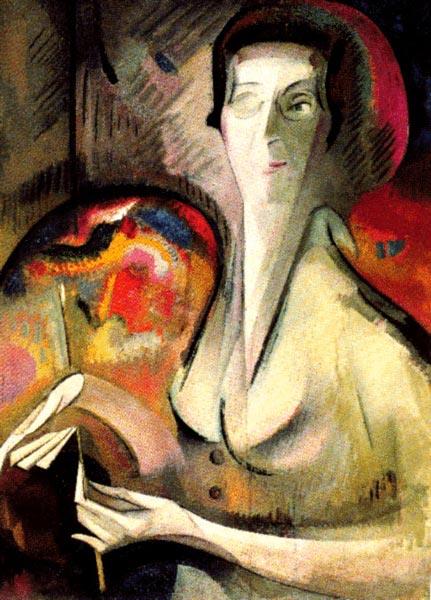Description
In the field of modern art, we highlight a singular and transgressive figure: Alice Bailly. His "self -portrait" of 1917, known in English as "Self -Portrait - 1917", is a work that invites us to explore not only the identity of the artist, but also the stylistic innovations with which Bailly revigorizes the tradition of the portrait.
Alice Bailly, born in Switzerland in 1872, is an outstanding figure within Fauvism and Cubism, two movements that defined much of European art in the first decades of the twentieth century. The influence of these currents is palpable in their "self -portrait - 1917", a piece that, at first glance, can baffle for its structure and chromatic choice, however, it reveals a deep self -understanding and an artistic courage.
When observing the paint, the use of fragmented forms and vibrant colors that are characteristic of Cubism can be noticed. The composition is constructed through colored blocks and geometric shapes, giving it an inherent dynamism. The figure represented, presumably a self -portrait of Bailly, is treated with a stylization that suggests both a decomposition and an recomposition of the human form. This duality offers a rich visual narrative about the condition of identity in times of change and conflict, since the work occurred in the first World War.
The color in this self -portrait deserves particular attention. Bailly uses a varied palette, in which cold and green tones predominate, contrasted with warm red and yellow flashes. This combination results in a vibrant piece that resists being static. The strength of color and shapes seems to suggest an attempt to capture the energy and spirit of the moment, while reflecting the introspection of the artist about her own circumstance and psyche.
An intriguing aspect of this work is the partial representation of the face, a decision that could be interpreted as the reflection of the fragmented nature of identity and the self in the turbulent context of the time. Bailly seems to play with the idea of presentation and concealment, allowing a vision of its interiority, while simultaneously it is suggested that there are parts of itself that remain out of sight.
Alice Bailly not only stands out for this self -portrait, but also for its wide production in which he explored various media, from oil to collage with wool, being one of the pioneers in this technique. Compared to other self -portraits of his time, Bailly's work offers a more abstract and symbolic approach, moving away from realism that still predominated in many of his contemporaries. Obviously influenced by masters of Cubism such as Pablo Picasso and Georges Braque, Bailly, however, printed in his work a freshness and originality that distinguishes it.
In summary, the "Self -portrait - 1917" by Alice Bailly is not only a personal representation, but also an aesthetic and conceptual statement that invites us to reflect on the multiplicity of human and artistic experience. In a sea of predictable and traditional portraits, Bailly's piece emerges as a lighthouse of innovation and self -expression, affirming its place in the history of modern art and reminding us of the ability of art to capture the complexity of existence in times of uncertainty and transformation .
KUADROS ©, a famous paint on your wall.
Hand-made oil painting reproductions, with the quality of professional artists and the distinctive seal of KUADROS ©.
Art reproduction service with satisfaction guarantee. If you are not completely satisfied with the replica of your painting, we refund your money 100%.

